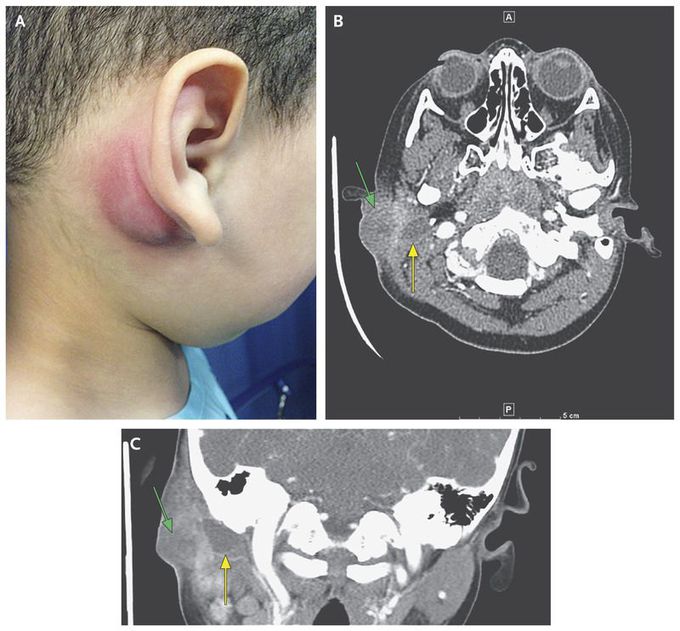


First Branchial Cleft Cyst
A 3-year-old boy presented to the emergency department with pain in the right ear and swelling in the postauricular area that had begun 3 days earlier. His father reported that the boy had had a whitish discharge from his right ear 8 days earlier, for which a pediatrician had prescribed antibiotic eardrops. The patient had no fever or leukocytosis. On physical examination, the swollen postauricular area was fluctuant and tender (Panel A), and white secretions were observed in the external auditory canal. A computed tomographic scan of the temporal bone (Panels B and C) showed a hypointense cystic fluid collection (yellow arrows) with adjacent inflammation (green arrows) in the perimastoid area. There was no evidence of an infectious process in the middle ear or mastoid area. The patient was taken to the operating room, where examination of the right external auditory canal revealed a small fistula track, which raised suspicion of a first branchial cleft cyst. When gentle pressure was applied to the swollen postauricular area, keratin debris and purulence were expressed through the tract and into the osteocartilaginous junction of the ear canal (see video). In a child who presents with a neck mass, the diagnosis of a branchial cleft anomaly should be considered in addition to inflammatory, infectious, congenital, and neoplastic processes. Branchial cleft defects can manifest as cysts, sinuses, or fistulas. Branchial clefts are categorized into first, second, and third branchial cleft defects, depending on the location of the defect. First branchial cleft anomalies account for less than 10% of all branchial cleft defects; have close involvement with the external auditory canal, the facial nerve, or both; and are typically located in the periauricular area. Approximately 6 weeks after presentation, the cyst was excised in the operating room. On follow-up, the surgical site was well healed, and the patient has not had any further issues.
Are these cysts occur only due to birth defects or any acquired bone defect (infection after trauma) may also cause them.. ?

